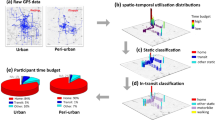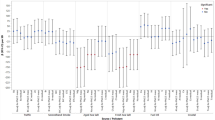Abstract
Recent epidemiology studies of power-frequency magnetic fields and reproductive health have characterized exposures using data collected from personal exposure monitors over a single day, possibly resulting in exposure misclassification due to temporal variability in daily personal magnetic field exposure metrics, but relevant data in adults are limited. We assessed the temporal variability of daily central tendency (time-weighted average, median) and peak (upper percentiles, maximum) personal magnetic field exposure metrics over 7 consecutive days in 100 pregnant women. When exposure was modeled as a continuous variable, central tendency metrics had substantial reliability, whereas peak metrics had fair (maximum) to moderate (upper percentiles) reliability. The predictive ability of a single-day metric to accurately classify participants into exposure categories based on a weeklong metric depended on the selected exposure threshold, with sensitivity decreasing with increasing exposure threshold. Consistent with the continuous measures analysis, sensitivity was higher for central tendency metrics than for peak metrics. If there is interest in peak metrics, more than 1 day of measurement is needed over the window of disease susceptibility to minimize measurement error, but 1 day may be sufficient for central tendency metrics.
This is a preview of subscription content, access via your institution
Access options
Subscribe to this journal
Receive 6 print issues and online access
$259.00 per year
only $43.17 per issue
Buy this article
- Purchase on Springer Link
- Instant access to full article PDF
Prices may be subject to local taxes which are calculated during checkout


Similar content being viewed by others
References
Bergqvist UO . Video display terminals and health. A technical and medical appraisal of the state of the art. Scan J Work Environ Health 1984; 10 (suppl 2): 1–87.
Bryant HE, Love EJ . Video display terminal use and spontaneous abortion risk. Int J Epidemiol 1989; 18: 132–138.
Ericson A, Kallen B . An epidemiological study of work with video screens and pregnancy outcome: I. a registry study. Am J Ind Med 1986; 9: 447–457.
Ericson A, Kallen B . An epidemiological study of work with video screens and pregnancy outcome: II. a case-control study. Am J Ind Med 1986; 9: 459–475.
Goldhaber MK, Polen MR, Hiatt RA . The risk of miscarriage and birth defects among women who use visual display terminals during pregnancy. Am J Ind Med 1988; 13: 695–706.
Grasso P, Parazzini F, Chatenoud L, Di Cintio E, Benzi G . Exposure to video display terminals and risk of spontaneous abortion. Am J Ind Med 1997; 32: 403–407.
Lindbohm ML, Hietanen M, Kyyronen P, Sallmen M, von Nandelstadh P, Taskinen H et al. Magnetic fields of video display terminals and spontaneous abortion. Am J Epidemiol 1992; 136: 1041–1051.
McDonald AD, Cherry NM, Delorme C, McDonald JC . Visual display units and pregnancy: evidence from the Montreal survey. J Occup Med 1986; 28: 1226–1231.
Nielsen CV, Brandt LPA . Spontaneous abortion among women using video display terminals. Scand J Work Environ Health 1990; 16: 323–328.
Roman E, Beral V, Pelerin M, Hermon C . Spontaneous abortion and work with video display units. Br J Ind Med 1992; 49: 507–512.
Schnorr TM, Grajewski BA, Hornung RW, Thun MJ, Egeland GM, Murray WE et al. Video display terminals and the risk of spontaneous abortion. New Eng J Med 1991; 324: 727–733.
Windham GC, Fenster L, Swan SH, Neutra RR . Use of video display terminals during pregnancy and risk of spontaneous abortion, low birthweight, or intrauterine growth retardation. Am J Ind Med 1990; 18: 675–688.
Belanger K, Leaderer B, Hellenbrand K, Holford TR, McSharry JE, Power ME et al. Spontaneous abortion and exposure to electric blankets and heated water beds. Epidemiology 1998; 9: 36–42.
Juutilainen J, Matilainen P, Saarikoski S, Laara E, Suonio S . Early pregnancy loss and exposure to 50-Hz magnetic fields. Bioelectromagetics 1993; 14: 229–236.
Lee GM, Neutra RR, Hristova L, Yost M, Hiatt RA . The use of electric bed heaters and the risk of clinically recognized spontaneous abortions. Epidemiology 2000; 11: 406–415.
Savitz DA, Ananth CV . Residential magnetic fields, wire codes, and pregnancy outcome. Bioelectromagnetics 1994; 15: 271–273.
Wertheimer N, Leeper E . Fetal loss associated with two seasonal sources of electromagnetic field exposure. Am J Epidemiol 1989; 129: 220–224.
Wertheimer N, Leeper E . Possible effects of electric blankets and heated waterbeds on fetal development. Bioelectromagnetics 1986; 7: 13–22.
Savitz DA . Magnetic fields and miscarriage. Epidemiology 2002; 13: 1–4.
Lee GM, Neutra RR, Hristova L, Yost M, Hiatt RA . A nested case-control study of residential and personal magnetic field measures and miscarriages. Epidemiology 2002; 13: 21–31.
Li DK, Odouli R, Wi S, Janevic T, Golditch I, Bracken TD et al. A population-based prospective cohort study of personal exposure to magnetic fields during pregnancy and the risk of miscarriage. Epidemiology 2002; 13: 9–20.
Savitz DA, Herring AH, Mezei G, Evenson KR, Terry JW, Jr, Kavet R . Physical activity and magnetic field exposure in pregnancy. Epidemiology 2006; 17: 222–225.
Li DK, Chen H, Odouli R . Maternal exposure to magnetic fields during pregnancy in relation to the risk of asthma in offspring. Arch Pediatr Adolesc Med 2011; 165: 945–950.
Li DK, Yan B, Li Z, Gao E, Miao M, Gong D et al. Exposure to magnetic fields and the risk of poor sperm quality. Reprod Toxicol 2010; 29: 86–92.
Mezei G, Bracken TD, Senior R, Kavet R . Analyses of magnetic-field peak-exposure summary measures. J Expo Sci Environ Epidemiol 2006; 16: 477–485.
Evenson KR, Wen F, Hillier A, Cohen DA . Assessing the contribution of parks to physical activity using global positioning system and accelerometry. Med Sci Sports Exerc 2013; 45: 1981–1987.
Hawkins MS, Storti KL, Richardson CR, King WC, Strath SJ, Holleman RG et al. Objectively measured physical activity of USA adults by sex, age, and racial/ethnic groups: a cross-sectional study. Int J Behav Nutr Phys Act 2009; 6 doi:10.1186/1479-5868-6-31.
Jilcott SB, Evenson KR, Laraia BA, Ammerman AS . Association between physical activity and proximity to physical activity resources among low-income, midlife women. Prev Chronic Dis 2007; 4: A04.
Troiano RP, Berrigan D, Dodd KW, Mâsse LC, Tilert T, McDowell M . Physical activity in the United States measured by accelerometer. Med Sci Sports Exerc 2008; 40: 181–188.
Buchowski MS, Choi L, Majchrzak KM, Acra S, Mathews CE, Chen KY . Seasonal changes in amount and patterns of physical activity in women. J Phys Act Health 2009; 6: 252–261.
Hankinson SE, Manson JE, Spiegelman D, Willett WC, Longcope C, Speizer FE . Reproducibility of plasma hormone levels in postmenopausal women over a 2-3-year period. Cancer Epidemiol Biomarkers Prev 1995; 4: 649–654.
Landis JR, Koch GG . The measurement of observer agreement for categorical data. Biometrics 1977; 33: 159–174.
Zaffanella LE, Kalton GW Survey of Personal Magnetic Field Exposure. Phase II: 1000-Person Survey. Enertech Consultants, Lee, MA 1998 Available from http://www.emf-data.org/rapid6-report.html.
Bracken TD . Supplemental Analyses of Magnetic Field Personal Exposure Data From the Kaiser Spontaneous Abortion Study. T. Dan Bracken, Inc.: Portland, OR. 2002 Available from http://www.ehib.org/emf/BrackenReport.pdf.
Rankin RF, Bracken TD, Senior RS, Kavet R, Montgomery JH . Results of a multisite study of U.S. residential magnetic fields. J Expo Anal Environ Epidemiol 2002; 12: 9–20.
White E, Armstrong BK, Saracci R . Reducing measurement error and its effects. In: White E, Armstrong BK, Saracci R (eds). Principles of Exposure Measurement in Epidemiology: Collecting, Evaluating, and Improving Measures of Disease Risk Factors. Oxford University Press: New York. 2008 pp 141–171.
Acknowledgements
Work was supported by contract CP P12618/C6280 from the Electric Power Research Institute and grant HD37584 from the National Institutes of Health. We thank Sarah Causey, Chyrise Bradley, and James Terry, Jr. for their work in the original analysis and the participating clinics for allowing us to recruit study participants in those settings.
Author information
Authors and Affiliations
Corresponding author
Ethics declarations
Competing interests
The authors declare no conflict of interest.
Additional information
Supplementary Information accompanies the paper on the Journal of Exposure Science and Environmental Epidemiology website
Supplementary information
Rights and permissions
About this article
Cite this article
Lewis, R., Evenson, K., Savitz, D. et al. Temporal variability of daily personal magnetic field exposure metrics in pregnant women. J Expo Sci Environ Epidemiol 25, 58–64 (2015). https://doi.org/10.1038/jes.2014.18
Received:
Revised:
Accepted:
Published:
Issue Date:
DOI: https://doi.org/10.1038/jes.2014.18
This article is cited by
-
Prenatal exposure to extremely low frequency magnetic field and its impact on fetal growth
Environmental Health (2019)
-
Analysis of personal and bedroom exposure to ELF-MFs in children in Italy and Switzerland
Journal of Exposure Science & Environmental Epidemiology (2016)



